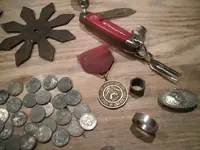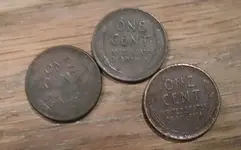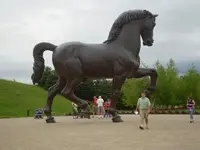The Beep Goes On
Silver Member
- Joined
- Jan 11, 2006
- Messages
- 3,403
- Reaction score
- 208
- Golden Thread
- 0
- Location
- Houston, TX
- Detector(s) used
- CTX3030, Excalibur II, V3i, TRX
- Primary Interest:
- Metal Detecting
These are descriptions from someone selling the actual cartridges (regarding the rimfire)... http://www.mcpheetersantiquemilitaria.com/06_ammunition/06_item_025.htm
.44 RIM FIRE LONG; lead bullet; hs “U”; introduced during the Civil War
.44 RIM FIRE EXTRA LONG; lead bullet; hs None; ca. 1870’s Ballard, Remington, F. Wesson Rifles
~~~
I also thought this was informative... http://www.shootingtimes.com/ammunition/st_0301_blackpowder/
Black Powder Magnums
Although the term "magnum" was not applied to cartridges until well into the 20th century,the quest for more power dates back to the birth of metallic cartridges.
By Mike Venturino
.44 Russ, .44 WCF .45 Colt
Magnum cartridges are an accepted part of today's shooting world, even to the point where many firearms and ammunition companies have developed their own lines of more powerful cartridges (witness the Ultra Mags from Remington and Winchester's Short Magnums). But the quest for more power from handguns and rifles is not new. It is as old as metallic cartridges themselves.
Back in the 1870s, in the first decade of centerfire, reloadable cartridges, various gun and ammunition companies also worked at ways of getting more powder under bullets. The term "magnum" as regards firearms had not yet been coined, but the effect was still the same. Focusing on the year 1878, mainly because I own a couple of firearms catalogs from that year, I'd like to show you what the biggest and most powerful cartridges were during the wildest time of the "Wild West."
Sixguns
Starting with revolvers, there were only two 1878 cartridges that achieved true power by our modern standards. First was the .45 Colt, introduced by that company in 1873 as a caliber for the venerable Single Action Army. Then came the .44 Winchester Centerfire (WCF), which we commonly call .44-40 today. It originated as a rifle round, albeit a very weak one, and was accommodated in revolvers by Colt in about 1877. (Some sources give 1878).
Before the advent of the .45 Colt in 1873, Smith & Wesson and Colt introduced several big-bore cartridges for use in their holster revolvers. For instance, there was the .44 S&W American, .44 S&W Russian, and .44 Colt. Also the .44 Henry Rimfire was adapted from lever guns for revolver use. None of these cartridges pushed a bullet in excess of 750 fps, and all would be considered pipsqueaks today.
I've had the opportunity to duplicate vintage loads in vintage revolvers chambered for all the calibers I've listed. Here are some specifics on one example. I pulled apart a handful of original .44 Colt blackpowder factory loads by UMC. They contained 21 grains of powder under a 208-grain lead bullet. I loaded those same bullets in fresh Starline brass (Dept. ST, 1300 W. Henry St., Sedalia, MO 65301; www.starlinebrass.com) charged with CCI 350 Large Pistol Magnum primers and carrying 21 grains of Goex FFg blackpowder. From the eight-inch barrel of a Colt Richards Conversion, that load chronographed only 742 fps.
.44 Henry Rimfire, .44 WCF, .45-75 WCF
Now imagine the impact the .45 Colt and .44 WCF cartridges must have had on handgun shooters of the 1870s. Some early .45 Colt factory loads carried as much as 40 grains of blackpowder under 250-grain bullets. That charge was quickly deemed too hot, and the factories thereafter loaded 35 grains. That load easily permitted velocities in excess of 900 fps from 7 1/2-inch barrel lengths. Factory .44 WCF loads used 200-grain bullets, but they contained a full 40-grain charge of blackpowder. Again from the 7 1/2-inch barrel of Colt SAAs, velocities passed 900 fps. These two handgun cartridges were the tops in their day. A look at the size of the .45 Colt and .44 WCF cases compared to the smaller rounds mentioned helps explain their power. The .45's case was 1.29 inches long, or the same as today's .357, .41, and .44 Magnums, and the .44-40's was a bit longer at 1.31 inches. The .44 S&W American case was only .91 inch, the .44 S&W Russian was .97 inch, and the .44 Colt and .45 S&W were only 1.10 inches. Colt chambered both of its super-powerful revolver cartridges of 1878 in the SAA and the then-new double-action Model 1878. Oddly enough, no other company made handguns for the .45 Colt cartridge (disregarding a few special test samples of Remington's Model 1875), but every manufacturer of holster-size handguns of the late 1800s chambered revolvers for .44 WCF.
...
~~~
http://findarticles.com/p/articles/mi_m0BTT/is_177_29/ai_n14816289/
Those are the lyrics from an old Marty Robbins song titled Mr. Shorty. It shows how intertwined the .44 caliber is with American legend and folklore. Since the beginning of cartridge-firing revolvers the .44 caliber has been in the forefront. Take the Colt Single Action Army for instance. Between 1873 and 1941 more were made in .45 Colt than any other single caliber, but look at how many different .44 caliber cartridges were offered. Colt SAAs were chambered for .44 WCF (.44-40), .44 Colt, .44 American, .44 Russian, .44 Special and the .44 Henry rimfire. In tact the first couple of Colt SAAs made for U.S. Government testing were in .44 Russian and .44 American calibers but the decision was made by the military to switch to .45s as the bore size for both long guns and handguns.
The second most prominent handgun manufacturer of the late 1800s was Smith & Wesson. Between 1870 and 1912 they sold over a quarter million of their large frame top break revolvers, collectively named the Model No. 3. The vast bulk of them were in .44 caliber. Those were split between .44 Henry rimfires, .44 Americans and .44 Russian; mostly the latter one. Then circa 1907 they introduced their first large frame revolver with a side-swing cylinder. Its premier chambering and the 20th century's first new .44 cartridge was the .44 S&W Special. Nearly 50 years later they followed it up with the ultimate .44--the .44 Remington Magnum.
History's Mystery
Although Colt and Remington used .44 caliber in their cap & ball revolvers, it was Smith & Wesson that got the ball rolling on .44 caliber metallic cartridges in 21870. And, they did it by chambering their first Model No. 3s for a Winchester "rifle" cartridge. Yes, I said rifle cartridge. That was the .44 Henry rimfire, and it was a mighty puny rifle cartridge, what with a 200 grain bullet with 23 to 28 grains of blackpowder. It had to be puny if a relatively weak top break handgun mechanism could safely hold it.
.44 RIM FIRE LONG; lead bullet; hs “U”; introduced during the Civil War
.44 RIM FIRE EXTRA LONG; lead bullet; hs None; ca. 1870’s Ballard, Remington, F. Wesson Rifles
~~~
I also thought this was informative... http://www.shootingtimes.com/ammunition/st_0301_blackpowder/
Black Powder Magnums
Although the term "magnum" was not applied to cartridges until well into the 20th century,the quest for more power dates back to the birth of metallic cartridges.
By Mike Venturino
.44 Russ, .44 WCF .45 Colt
Magnum cartridges are an accepted part of today's shooting world, even to the point where many firearms and ammunition companies have developed their own lines of more powerful cartridges (witness the Ultra Mags from Remington and Winchester's Short Magnums). But the quest for more power from handguns and rifles is not new. It is as old as metallic cartridges themselves.
Back in the 1870s, in the first decade of centerfire, reloadable cartridges, various gun and ammunition companies also worked at ways of getting more powder under bullets. The term "magnum" as regards firearms had not yet been coined, but the effect was still the same. Focusing on the year 1878, mainly because I own a couple of firearms catalogs from that year, I'd like to show you what the biggest and most powerful cartridges were during the wildest time of the "Wild West."
Sixguns
Starting with revolvers, there were only two 1878 cartridges that achieved true power by our modern standards. First was the .45 Colt, introduced by that company in 1873 as a caliber for the venerable Single Action Army. Then came the .44 Winchester Centerfire (WCF), which we commonly call .44-40 today. It originated as a rifle round, albeit a very weak one, and was accommodated in revolvers by Colt in about 1877. (Some sources give 1878).
Before the advent of the .45 Colt in 1873, Smith & Wesson and Colt introduced several big-bore cartridges for use in their holster revolvers. For instance, there was the .44 S&W American, .44 S&W Russian, and .44 Colt. Also the .44 Henry Rimfire was adapted from lever guns for revolver use. None of these cartridges pushed a bullet in excess of 750 fps, and all would be considered pipsqueaks today.
I've had the opportunity to duplicate vintage loads in vintage revolvers chambered for all the calibers I've listed. Here are some specifics on one example. I pulled apart a handful of original .44 Colt blackpowder factory loads by UMC. They contained 21 grains of powder under a 208-grain lead bullet. I loaded those same bullets in fresh Starline brass (Dept. ST, 1300 W. Henry St., Sedalia, MO 65301; www.starlinebrass.com) charged with CCI 350 Large Pistol Magnum primers and carrying 21 grains of Goex FFg blackpowder. From the eight-inch barrel of a Colt Richards Conversion, that load chronographed only 742 fps.
.44 Henry Rimfire, .44 WCF, .45-75 WCF
Now imagine the impact the .45 Colt and .44 WCF cartridges must have had on handgun shooters of the 1870s. Some early .45 Colt factory loads carried as much as 40 grains of blackpowder under 250-grain bullets. That charge was quickly deemed too hot, and the factories thereafter loaded 35 grains. That load easily permitted velocities in excess of 900 fps from 7 1/2-inch barrel lengths. Factory .44 WCF loads used 200-grain bullets, but they contained a full 40-grain charge of blackpowder. Again from the 7 1/2-inch barrel of Colt SAAs, velocities passed 900 fps. These two handgun cartridges were the tops in their day. A look at the size of the .45 Colt and .44 WCF cases compared to the smaller rounds mentioned helps explain their power. The .45's case was 1.29 inches long, or the same as today's .357, .41, and .44 Magnums, and the .44-40's was a bit longer at 1.31 inches. The .44 S&W American case was only .91 inch, the .44 S&W Russian was .97 inch, and the .44 Colt and .45 S&W were only 1.10 inches. Colt chambered both of its super-powerful revolver cartridges of 1878 in the SAA and the then-new double-action Model 1878. Oddly enough, no other company made handguns for the .45 Colt cartridge (disregarding a few special test samples of Remington's Model 1875), but every manufacturer of holster-size handguns of the late 1800s chambered revolvers for .44 WCF.
...
~~~
http://findarticles.com/p/articles/mi_m0BTT/is_177_29/ai_n14816289/
Those are the lyrics from an old Marty Robbins song titled Mr. Shorty. It shows how intertwined the .44 caliber is with American legend and folklore. Since the beginning of cartridge-firing revolvers the .44 caliber has been in the forefront. Take the Colt Single Action Army for instance. Between 1873 and 1941 more were made in .45 Colt than any other single caliber, but look at how many different .44 caliber cartridges were offered. Colt SAAs were chambered for .44 WCF (.44-40), .44 Colt, .44 American, .44 Russian, .44 Special and the .44 Henry rimfire. In tact the first couple of Colt SAAs made for U.S. Government testing were in .44 Russian and .44 American calibers but the decision was made by the military to switch to .45s as the bore size for both long guns and handguns.
The second most prominent handgun manufacturer of the late 1800s was Smith & Wesson. Between 1870 and 1912 they sold over a quarter million of their large frame top break revolvers, collectively named the Model No. 3. The vast bulk of them were in .44 caliber. Those were split between .44 Henry rimfires, .44 Americans and .44 Russian; mostly the latter one. Then circa 1907 they introduced their first large frame revolver with a side-swing cylinder. Its premier chambering and the 20th century's first new .44 cartridge was the .44 S&W Special. Nearly 50 years later they followed it up with the ultimate .44--the .44 Remington Magnum.
History's Mystery
Although Colt and Remington used .44 caliber in their cap & ball revolvers, it was Smith & Wesson that got the ball rolling on .44 caliber metallic cartridges in 21870. And, they did it by chambering their first Model No. 3s for a Winchester "rifle" cartridge. Yes, I said rifle cartridge. That was the .44 Henry rimfire, and it was a mighty puny rifle cartridge, what with a 200 grain bullet with 23 to 28 grains of blackpowder. It had to be puny if a relatively weak top break handgun mechanism could safely hold it.



 That was so sweet of you two! I can't wait to go huntin' and try them out.
That was so sweet of you two! I can't wait to go huntin' and try them out. 
 You all just went wild in the desert, huh? I even heard a tale that there were monkeys in the trees there!
You all just went wild in the desert, huh? I even heard a tale that there were monkeys in the trees there! 











